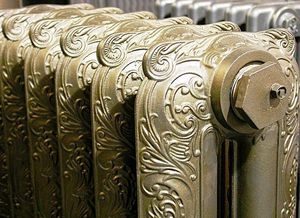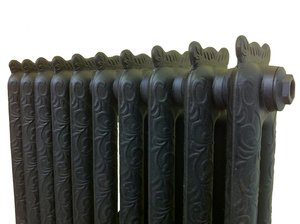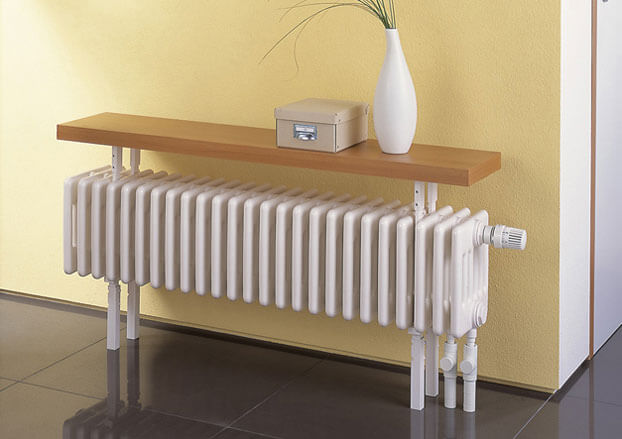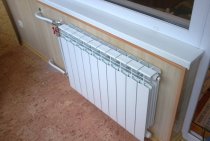How much water is in one section of an aluminum radiator
Nowadays, replacing old cast-iron batteries with new models has become not a tribute to fashion, but a vital necessity. Concern for the safety of the heating system and attempts to reduce the cost of utilities have led to the fact that more and more consumers opt for aluminum radiators, which differ from other types of heaters, both in technical characteristics and in price. One of the important parameters is the volume of the heating radiator.
Parameters of aluminum radiators
The technical characteristics of heating batteries are the first thing that the consumer pays attention to before buying. The most important indicators of a truly high-quality product are:
- The level of heat transfer of one section, since it depends on:
- First, how many elements are required to heat one room.
- Secondly, how warm it will be in the room thanks to the radiator.
- Thirdly, what will be the microclimate in the room.
- Water hammer resistance and working pressure of aluminum radiator.
- The cost of the finished product.
The volume of one section of an aluminum radiator indicates its power and largely depends on how it was made.
If the aluminum battery was made by pressing, then its parts were connected with glue, which makes it vulnerable. Corrosion is not terrible for such a radiator, but increased pressure can disable it.
The capacity of one section of an aluminum radiator, no matter how it was produced, is almost the same, but the fact that the cast model is stronger and more durable, heats up faster and can be adjusted in size, puts them in first place in sales.
Types of coolants
As a rule, the question of which coolant is used in a centralized heating system is not asked, since water always flows through the heat pipe there. Another thing is autonomous heating, where you can choose the best option for a particular house, taking into account the climate of the region where it is built.
Why is the volume of the radiator important?
Calculating how many liters in one section of an aluminum radiator is important for several reasons:
Considering how many factors the volume of heating batteries affects, this parameter should be taken into account when choosing aluminum products.
Calculation of the volume of an aluminum radiator
There are two ways to determine the capacity of a heating battery:
This, although a very time-consuming method, is the most reliable and accurate, since manufacturers can overestimate or underestimate the parameters of their products in the technical documentation.
When choosing the type of radiator, you should pay attention to the difference in the parameters of domestic and foreign manufacturers. Some indicators may look very attractive, but not suitable for a centralized Soviet heating system
You also need to think in advance which coolant will be used in the network, and make calculations indicating its viscosity.
Summing up, we can say that the volume of an aluminum radiator is an important parameter that must be taken into account in order for the system to work truly efficiently in the future.
Low batteries
Radiators with a small center distance have the following advantages:
- they can be placed under a low window sill;
- they have the maximum heat transfer per unit area.
Cast iron radiators .
The dimensions of the sections of heating radiators MS-140M-300-0.9 are:
- length 93 mm;
- depth - 140 millimeters;
- height - 388 millimeters.
Due to the smaller dimensions, the heat transfer of cast-iron heating radiators is reduced - it is equal to 106 watts from one section at an operating pressure of 9 kgf / cm².Among foreign analogues, there are cast-iron products with a center distance along the connections equal to 200 and 350 millimeters; the power of a section of a cast-iron radiator of this type is much higher.
Aluminum radiators. For low batteries made of aluminum, both domestic and imported, the spread in the value of the center distances is quite large. You can meet the sizes of radiators 150, 300 and even 450 millimeters. Since the possible length of the section starts from 40 millimeters, the device looks compact and unusual. Low aluminum heating radiators have height dimensions ranging from 200 millimeters. The depth of many models compensates for the lack of the other two parameters and is 180 millimeters.
As for the thermal power, it varies from a minimum of 50 watts per section to a maximum of 160 watts. The determining factor is the finning area of one section. At the same time, a change in dimensions does not significantly affect the working pressure - low aluminum devices are designed for 16 atmospheres, and when tested for 24 atmospheres. Bimetal radiators. All sizes of radiators that they have are also typical for aluminum heaters. Thermal power is within the same limits. On sale you can find aluminum low radiators, in which the heat transfer is 80 and 140 watts per section. Working pressure is 25-35 atmospheres.
Bimetallic low radiators, such as in the photo, have two nuances:
- among heaters, there are batteries not with solid steel cores, but with steel tubes placed between aluminum collectors. Their operating pressure, specified by the manufacturers, is usually 12 or 16 atmospheres;
- they often do not have vertically arranged channels and, in the case of lateral connection, can be heated from collectors due to the thermal conductivity of aluminum. The circulation of the coolant is provided by the last section, since it is flowing.
The volume of water in the heating radiator aluminum, cast iron, bimetallic
There are many reasons why you may need to know the volume of water in a heating radiator. The easiest way is to look in the specification, instructions or other documentation for the product. But what if it doesn't exist?
From this article you will find out how many liters of water are in one section of a heating radiator, depending on its model and dimensions. We will also tell you how to calculate this indicator for non-standard models.
How much water is in one section of a cast-iron heating radiator
Cast iron batteries differ in section height, depth, power and weight. For example, the model MC 140-500 has a height of 50 mm and a depth of 140 mm. Basically, the volume of water in the cast-iron section of the radiator is affected by its height.
The most common is the MS series. Depending on the manufacturer, the volume of the coolant may vary, so there is a slight variation.
The volume of one section of the brand MS (in liters)
- MS 140-300 - 0.8-1.3,
- MS 140-500 - 1.3-1.8,
- MS-140 - 1.1-1.4,
- MS 90-500 - 0.9-1.2,
- MS 100-500 - 0.9-1.2,
- MS 110-500 - 1-1.4.
Cast-iron batteries of the ChM series are very popular. The model marking indicates the number of channels, the height and depth of the section. For example, ChM2-100-300 has a height of 300 mm, a depth of 100 mm, and water circulates in it through two channels.
The volume of water in one section of the ChM brand (in liters)
- ChM1-70-300 - 0.66,
- ChM1-70-500 - 0.9,
- ChM2-100-300 - 0.7,
- ChM2-100-500 - 0.95,
- ChM3-120-300 - 0.95,
- ChM3-120-500 - 1.38.
The volume of water in one section of the aluminum radiator
There are dozens of manufacturers of aluminum radiators, the products of each of them differ in the design and size of the internal channels. Therefore, one can only approximately say how much water is in one section of an aluminum radiator.
The main difference between the models is in height, so here is a list of the most common sizes (data are in liters):
- 350 mm - 0.2-0.3,
- 500 mm - 0.35-0.45,
- 600 mm - 0.4-0.5,
- 900 mm - 0.6-0.8,
- 1200 mm - 0.8-1.
For non-standard sizes, you can use the formula (V - volume in liters, h - height in meters):
V = h x 0.8
The result will be approximate, but if there is no specification for the equipment at hand, you can use the value obtained. So you can determine how much water is in one fin of an aluminum battery with an error of no more than 20%.
Note that the capacity of an aluminum heating radiator may decrease over time due to the appearance of corrosion. It is formed due to water with poor alkalinity or acidity. Also, the volume of liquid in an aluminum radiator can be reduced due to silting.
How much water is in one section of a bimetallic radiator
As in the case of aluminum, there are many options for manufacturers and brands of bimetallic radiators. In the same way, their structure, appearance, and channel diameters differ.
The volume of water in a bimetallic radiator depends on its height and is (in liters):
- 35 cm - 0.1-0.15,
- 50 cm - 0.2-0.3,
- 60 cm - 0.25-0.35,
- 90 cm - 0.3-0.5,
- 120 cm - 0.4-0.6.
To calculate the volume of a section of a bimetallic radiator of non-standard height, use the formula (V - volume in liters, h - height in meters):
V = h x 0.35
So you get an approximate value, which can fluctuate within 20%.
Storage and wear processes
To reduce the risk of battery deterioration during long-term storage, the following guidelines should be followed:
- do not allow complete discharge;
- storage temperature not lower than -20 °C and not higher than +30 °C;
- charge annually for 48 hours;
- The surface of the battery must be clean to avoid self-discharge.
The main processes that destroy a lead-acid battery:
- Sulfation is the formation of crystals of lead salts. They are deposited on the plates and prevent the normal flow of current.
- Corrosion is an oxidative process that destroys lead battery electrodes.
- Shedding - the active mass in the cells of the positive electrodes loses its normal adhesion to the base and falls off.
- Adhesion defects also lead to slippage of the powdery contents of the conductive plates.
Failed batteries are not recoverable and are recycled. Heavy metal vapors can cause serious harm to humans and the environment, so artisanal smelting of lead from batteries is life-threatening.
Expert answers
Chairman:
5 square meters
Verik:
cast iron heats, and aluminum transfers the heat of the water in the radiator .. 350 mm is a stretch of 8 squares
Truculentus:
The passport for the radiator indicates the thermal power of one section of the radiator (for sectional batteries) or the same indicator of the entire radiator. This indicator differs for different manufacturers.
In practice, an approximate calculation is usually used, based on the fact that for heating 10 sq.m. a normally insulated room with a ceiling height of up to 3 m requires 1 kW of thermal power (100 W / sq.m). For corner rooms (2 outer walls), rooms with large windows (or several windows), the resulting value is increased by 20-25%.
Grandfather Au:
see how many watts it is according to the instructions, divide by 100, multiply by 0.8 and you will get square meters (this is the case with any radiator)
Vladimir Petrov:
As I understand it, 350 is the center distance and how many sections. Look on the Internet in the section. There's a bunch of batteries out there you can take their power ratings. And then count about 150 watts per square meter. In my country house on the terrace, somewhere around 14 square meters. m are two batteries of 12 sections of 350mm. I took with a margin. The windows are large 2400 by 140, two pieces there I have a winter garden. It's hotter at minus 25 outside.
pretzel:
Approximately 1 kW per 10 square meters of the house. 24 respectively 2.4 watts. One section approximately 150-200 watts Approximately 12-15 sections are needed. I have a house of 120 square meters, sections 5+5+5+10+5 = 30 second floor and 7+5+5+5=22 + warm floor first floor
Truculentus:
For heating a typical room in a 1 m³ panel house, 0.041 kW of thermal energy is required. To heat a room in a brick house with wall insulation (mineral wool, foam plastic) and installed double-glazed windows on windows per 1 m³, 0.034 kW of thermal energy is required. A double-glazed window will reduce heat loss by 15-20%, respectively, you can reduce the number of sections. If the room is angular, then the heat loss will be approximately 20% more. For premises built in accordance with the latest building codes, 0.020 kW of thermal energy is required per 1 m³. Any radiator on the package or in the complete insert has information about the thermal power.
Frosya Burlakova:
You can approximately determine how many sections of the radiator are needed if you multiply the area of \u200b\u200bthe room by 100 and divide by the heat transfer of the section (according to the passport) in watts. It should be remembered that the value obtained is approximate where a number of factors (heat losses of the room, heating network parameters and types of radiator connections) are not taken into account. 15 about
uncle Ivan:
At least 14, and it is better to install two blocks of 8 sections.
Andrey:
Not enough data for a correct answer. Specify: 1. temperature difference between your comfortable and minimum winter temperatures for your region. 2. the amount of heat loss from the surfaces of the heated room; 3. the frequency of air exchange from the room to the street and adjacent rooms; 5. how many windows are in the room. 6. Estimated temperature of the supply and return pipelines. 7. circulation speed and type of coolant. 8. Thermal power of the section declared by the manufacturer and under what temperature conditions. 9. You can also pressure in the system, but this is already nit-picking, since the effect on heat transfer is insignificant. We are waiting for the data, we immediately issue the exact answer.
Muryska:
oh yoyo what tricky answers)))))) we thought so for 2 square meters 1 section, now in the apartment 28-30C in the winter before the repair it was 20-22
Grandfather Au:
per square meter you need 100 watts, especially in a panel house! Do NOT take aluminum - especially if the skyscraper breaks! and they don't like our water very much
Smirnov Vladimir:
The required number of sections is determined by the formula: S rooms * H ceilings * window coefficient (35 - if double-glazed windows, 40 - if ordinary windows) / section heat transfer = number of sections. aluminum radiators have a heat dissipation of 190 watts
Valentina Bryzgalina:
The locksmith spoke. "What's the point of putting a lot of sections, if the pressure is small, then it will not push through to the end. » Often this happens, because (zheks, reu) they have big savings on this. I changed batteries and wanted 10-12 pcs. put in a room of 18 square meters. m. As a result, they put 8 pieces, the circulation is good, warm. 6 years are aluminum.
Ivan Krasnoshchok:
I used the table, see Kermi's website. about (only in English letters) is very convenient and sensibly written.
Egor Lvov:
why do you want it?
Modern models of heating radiators

The weight of 1 section is 3.8 kg. water holds 0.8 liters, so the mass of one section of the radiator with water will be 4.6 kg. With a heat flow of 140 W, 14 sections will be required to heat a room of 20 m2, respectively, by weight, 64.4 kg with water will come out. Thus, this indicator differs downward by 40% than that of the classic MS 140 sample. If this value is divided into two parts (32 kg each), then we can conclude that installation on walls made of modern materials, including porous concrete, It is quite possible to carry out without additional fasteners.
An even lighter design was developed by Russian manufacturers. Their heaters are offered under the EXEMET brand. the MODERN model has the following weight characteristics:
One section from this manufacturer weighs 3.2 kg, heat dissipation is 93 watts.To heat a room of 20 m2, 22 sections are required, then the total mass will be 70.4 kg. These parameters are not bad, especially considering that the company produces models with a possible installation on the floor.

The EXEMET FIDELIA model weighs 12 kg, heat dissipation is 156 W, the total weight of the device for our example is simply monstrous - 154 kg. The complex issue of installation is irrelevant here, since the first and last sections are equipped with legs for placing the device on the floor.
So, in order to ensure uninterrupted service for the heating system, such important indicators as the weight and volume of the battery section cannot be ignored. Due to the correct calculation of the load on the fasteners, you can count on the reliability of the installation and the long-term operation of the device.
Expert answers
Chairman:
5 square meters
Verik:
cast iron heats, and aluminum transfers the heat of the water in the radiator .. 350 mm is a stretch of 8 squares
Truculentus:
The passport for the radiator indicates the thermal power of one section of the radiator (for sectional batteries) or the same indicator of the entire radiator. This indicator differs for different manufacturers.
In practice, an approximate calculation is usually used, based on the fact that for heating 10 sq.m. a normally insulated room with a ceiling height of up to 3 m requires 1 kW of thermal power (100 W / sq.m). For corner rooms (2 outer walls), rooms with large windows (or several windows), the resulting value is increased by 20-25%.
Grandfather Au:
see how many watts it is according to the instructions, divide by 100, multiply by 0.8 and you will get square meters (this is the case with any radiator)
Vladimir Petrov:
As I understand it, 350 is the center distance and how many sections. Look on the Internet in the section. There's a bunch of batteries out there you can take their power ratings. And then count about 150 watts per square meter. In my country house on the terrace, somewhere around 14 square meters. m are two batteries of 12 sections of 350mm. I took with a margin. The windows are large 2400 by 140, two pieces there I have a winter garden. It's hotter at minus 25 outside.
vyachko:
Based on the empirical average ratio of 1kW per 10 sq. m area, then. For example, for a room of 20 square meters. m need a battery with a total power of 2 kW. One section of an aluminum radiator with a center distance of 500 mm at a temperature difference of 70 degrees gives 140 ... 200 W (need to be clarified for a specific brand of radiator). For 2kW, we get somewhere around 10 ... 14 sections.
Vyacheslav Koshelev:
and there is nothing more to answer ....
BOSS:
Read SNiP heat engineering. The number of radiators depends not so much on the area, but on the heat loss of the room (on the correctness of the selected enclosing structures: walls, floors, ceilings). Everyone fences a private house from the evil one ... (from money in your pocket). If you properly insulated and built ... then consider as it is written above ... if not, then turn to the calculator and SNiP.
Farit Gafuanov:
shorter one section two squares to be sure, take two more sections
Andrey:
Find out the rated thermal power of the section (all manufacturers indicate it for a supply of 90 degrees) 90 divided by the calculated supply temperature, you will get a reducing coefficient. Determine the approximate heat loss of one square meter of your walls from the tables and multiply by their outer area. , add the heat loss of Windows (table data multiplied by the area), add the heat loss of the ceiling, depending on the type of insulation or the presence of neighbors from above, they vary greatly. Add heat loss to the supply and exhaust ventilation. Set the winter regional co-op. air temperature and a comfortable indoor temperature for you. Based on this temperature difference and the amount of heat loss in the room, you determine how many kilowatts are required to maintain this temperature, divide these kilowatts by the actual power of the section and find out the minimum number of sections. The principle is simple; the more sections and the lower their temperature, the more efficient the heating.
Irina Manaeva:
1 section per 2-3 sq. m.
Oleg Khrebtov:
I always put 1 section on 1.5m. sq. Enough even in severe frosts ..
MIKA:
BOSS said everything correctly, we consider the heat loss of the premises
Maria:
Take it with a margin - you will twist the valves.In the corners, too, does not hurt - outdoor and at the entrance for a pillow.
Gennady Skvortsov:
it's nice to read the opinions of experts, I want to add only about the priority location under the windows and to the front doors
pavel pavlov:
put the more the better... be realistic - if you're not special, damn you calculate the possible heat loss, and other garbage, it's better to proceed from what pressure you have in the pipe - how many sections it can push through. but it will be hot, turn down the agv, and this again saves gas ...
What should be the dimensions
In order for the heating radiator to give off maximum heat (in this case, we are not talking about its thermal power, but about the efficiency of its work), the dimensions should be as follows:
- The length should be more than 70-75% of the width of the window opening.
- The height should be such that between the floor and the battery was 8-12 cm, and at the same time between the window sill and it was 6-12 cm.
If the recommendations are not followed, then the operation of the aluminum radiator will be accompanied by heat loss. Therefore, even if he can issue the necessary for a room with an area of 20 square meters. m 200 watts of heat, then due to incorrect dimensions in the room there will be insufficient heat. After all, part of it can be lost under the windowsill or go to floor heating.
When the length is less than 70% of the width of the window opening, the battery will not be able to create a thermal curtain that can block the movement of cold air entering through the window. The consequence of this situation will be the appearance of cold and warm zones in the room. Also, the windows will be constantly covered with steam. And even the power of the heating radiator, which is greater than the need, cannot become a lifesaver.
Therefore, if the window has a width of 2 m, then the length of the battery must be at least 1.4 m
Of course, in order to select a device with such a length, it will be necessary to take into account sections of different heights and their heat transfer. The calculation can take a long time, but it's worth it
Power aluminum radiator section
Many people note that the power of the heating radiator section, which the manufacturer indicated in the technical documentation, can be substituted into the formula for calculating the number of sections. This idea is correct in the case when a coolant with a temperature of 100 °C circulates in the heating system, and it is cooled down to 80 °C. The fact is that manufacturers indicate the heat transfer of the battery under the condition of ΔТ = 70 ° С. They calculated this indicator based on the formula:
- where t1 represents the temperature of the heating medium at the inlet,
- t2 is the temperature of the coolant at the outlet,
- t3 represents the room temperature of the house.
ΔТ = 70 °С only when the coolant has the above temperature levels and t3 = 20 °С.
After that, they take a special plate in which the manufacturer indicated the heat transfer of the radiator at various ΔT, and look for the resulting indicator. Near it is a correction factor. For example, for ΔT = 50 ° C, it is 0.65. This figure is multiplied by the power of the radiator section. Further, the result can be substituted into the formula indicated at the very beginning.
Calculation example
If you calculate how many sections of an aluminum radiator you need for a room of 20 m2 at a rate of 100 W / m2, then you should also make adjustment coefficients for heat loss:
- each window adds 0.2 kW to the indicator;
- the door "costs" 0.1 kW.
If it is assumed that the radiator will be placed under the windowsill, then the correction factor will be 1.04, and the formula itself will look like this:
Q \u003d (20 x 100 + 0.2 + 0.1) x 1.3 x 1.04 / 72 \u003d 37.56
- the first indicator is the area of the room;
- the second is the standard number of W per m2;
- the third and fourth indicate that the room has one window and one door each;
- the next indicator is the level of heat transfer of an aluminum radiator in kW;
- the sixth is a correction factor regarding the location of the battery.
Everything should be divided by the heat transfer of one heater fin.It can be determined from the table from the manufacturer, which indicates the heating coefficients of the media in relation to the power of the device. The average value for one fin is 180 W, and the adjustment is 0.4. Thus, multiplying these figures, it turns out that 72 W is given by one section when the water is heated to +60 degrees.
Since rounding is done up, the maximum number of sections in an aluminum radiator specifically for this room will be 38 fins. To improve the performance of the structure, it should be divided into 2 parts of 19 ribs each.
Find out useful information about aluminum batteries on our website:
Characteristics of popular models Conner, MS 140, STI Nova
Cast iron batteries are produced by various manufacturing companies. There are many models in the range. Popular brands are cast-iron heating radiators Conner, MS 140, STI Nova.
Technical characteristics of popular models of cast iron radiators
| Name | Specifications | Peculiarities |
|---|---|---|
| MS 140 | - Working pressure is up to 9 atmospheres, maximum - up to 15 atmospheres. - Low heat dissipation - 175 watts. – There are two channels per section. – The dimensions of the sections are 50 cm high, 9.8 cm wide. - The capacious section is equal to 1.35 liters. - The battery is able to withstand heating of the coolant up to +130 degrees. | Cast iron appliances are made in accordance with GOST 8690-94. Depending on the distance between the axles, there can be five standard sizes of ms 140 radiators (300, 400, 500, 600, 800 mm). The most popular is the MS 140 500 model. |
| STI Nova 500 | - The working pressure is 12 atmospheres, the maximum is up to 16 atmospheres (water hammers are not terrible). - Thermal power - 1.5 kW (this is enough to heat a room of 15 m²). - The external design of the device resembles radiators made of steel or aluminum. | Russian cast iron appliances are of high quality and interesting design. The company has set average prices for its products. |
| Conner | - Power - 120-180 watts. – The maximum coolant temperature is + 110 degrees. - The working pressure is 12 atmospheres, the maximum is up to 20 atmospheres ( resistant to water hammer). – Wide channels that do not create much local resistance. | Affordable cost of devices. Leading positions in the market of heating equipment. Are issued in different complete sets, with various diameters of entrance pipes and different number of sections. The dimensions, weight and volume of one section of this model are somewhat reduced. |
Cast iron radiator MS 140
The cast-iron heating radiators discussed above boil down to the fact that the devices are high-quality, boast an excellent design, they warm up the rooms perfectly and last quite a long time.
It is easy to make a choice of a model for a particular heating system, you just have to take into account the technical characteristics of the devices. When choosing, remember the features of the room, the number of windows and walls facing the outside
After all, the model of cast iron radiator that is suitable for you also depends on this.
When choosing, remember about the features of the room, the number of windows and walls facing the outside. After all, the model of cast iron radiator that is suitable for you also depends on this.
If the radiator is chosen correctly, in accordance with all the characteristics, and corresponds to the heating room, then it will work with full efficiency, create a cozy and comfortable atmosphere.
General reviews of cast iron heating radiators in the network are mostly positive. Against the background of their minor shortcomings, they benefit from their changes in appearance and from the technical side. Of course, the service life of cast-iron heating batteries is the longest. Radiators can maintain a high coolant temperature for a long time after turning off the heating. Designs are not afraid of pressure drops and aggressive environments.Modern cast-iron heating radiators are an excellent choice for creating a favorable microclimate in the house and saving money.



